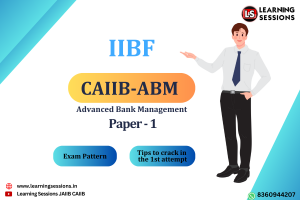CAIIB Exam is conducted biannually (twice a year) in June and December by the Indian Institute of Banking & Finance (IIBF) with the objective to transform candidates into competent decision-makers and leaders in the banking universe and to empower the candidates to develop expertise in multiple areas. Advanced Bank Management (ABM) is Paper 1 of the CAIIB exam. In this article, we will cover the CAIIB ABM exam pattern and tips to crack the “Advanced Bank Management” ABM paper in the first attempt. If you are an aspiring candidate for the CAIIB certification and want to clear the ABM paper in the first go, then keep reading the article-

Check Here
————————————————————-
Bank Financial Management - BFM Syllabus Priority
Check Here
————————————————————-
110+ CAIIB Case Study Videos
Check here
————————————————————-
ABM BFM Retail Previous Year Questions
Get Tests Here
————————————————————-
Full Course Videos in Hindi English
Check Here
CAIIB Advanced Bank Management (ABM) Paper Pattern
Number of questions -100
Marks – 100
Duration – 2 hours
CAIIB Syllabus: CAIIB Compulsory Subjects:
Paper 1: Advanced Bank Management (ABM)
Paper 2: Bank Financial Management (BFM)
Paper 3: Advanced Business and Financial Management (ABFM)
Paper 4: Banking Regulations and Business Laws (BRBL)
CAIIB Syllabus: CAIIB Elective Subjects:
- Rural Banking
- Human Resources Management
- Risk Management
- Central Banking
- Information Technology and Digital Banking
CAIIB ABM Syllabus 2024
Module A
|
Chapter |
Topics
|
|
Definition of Statistics, Importance & Limitations & Data Collection, Classification & Tabulation |
Importance of Statistics; Functions of Statistics; Limitation or Demerits of Statistics; Definitions; Collection of Data; Classification and Tabulation; Frequency Distribution. |
|
Sampling Techniques |
Random Sampling; Sampling Distributions; Sampling from Normal Populations; Sampling from Non-Normal Populations; Central Limit Theorem; Finite Population Multiplier. |
|
Measures of Central Tendency & Dispersion, Skewness, Kurtosis |
Arithmetic Mean; Combined Arithmetic Mean; Geometric Mean; Harmonic Mean; Median and Quartiles; Mode; Introduction to Measures of Dispersion; Range and Coefficient of Range; Quartile Deviation and Coefficient of Quartile Deviation; Standard Deviation and Coefficient of Variation; Skewness and Kurtosis. |
|
Correlation and Regression |
Scatter Diagrams; Correlation; Regression; Standard Error of Estimate |
|
Time Series |
Variations in Time Series; Trend Analysis; Cyclical Variation; Seasonal Variation; Irregular Variation; Forecasting Techniques |
|
Theory of Probability |
Mathematical Definition of Probability; Conditional Probability; Random Variable; Probability Distribution of Random Variable; Expectation and Standard Deviation; Binomial Distribution; Poisson Distribution; Normal Distribution; Credit Risk; Value at Risk; Option Valuation |
|
Estimation |
Estimates; Estimator and Estimates; Point Estimates; Interval Estimates; Interval Estimates and Confidence Intervals; Interval Estimates of the Mean from Large Samples; Interval Estimates of the Proportion from Large Samples. |
|
Linear Programming |
Graphic Approach; Simplex Method |
|
Simulation |
Simulation Exercise; Simulation Methodology |
Module B
|
Chapter |
Topics
|
|
Fundamentals of Human Resource Management |
The Perspective; Relationship between HRM & HRD and their Structure and Functions; Role of HR Professionals; Strategic HRM; Development of HR Functions in India |
|
Development of Human Resources |
HRD and its Subsystems; Learning and Development – Role and Impact of Learning; Attitude Development; Career Path Planning; Self-Development; Talent Management; Succession Planning |
|
Human Implications of Organisations |
Human Behaviour and Individual Differences; Employees Behaviour at Work; Diversity at Workplace and Gender Issues; Theories of Motivation and their Practical Implications; ‘Role’: Its Concept & Analysis |
|
Employees’ Feedback and Reward System |
Employees’ Feedback; Reward and Compensation System |
|
Performance Management |
Appraisal Systems; Performance Review and Feedback; Counselling; Competency Mapping and Assessment of Competencies; Assessment Centres; Behavioural Event Interview (BEI) |
|
Conflict Management and Negotiation |
Conflict: Concept & Definition; Characteristics of Conflict; Types of Conflicts; Reasons for Conflict; Different Phases of Conflict; Conflict Resolution; Conflict Management; Negotiation Skills for Resolution of Conflicts |
|
HRM and Information Technology |
Role of Information Technology in HRM; HR Information and Database Management; Human Resource Information System (HRIS); Human Resource Management System (HRMS); e–HRM; HR Research; Knowledge Management; Technology in Training; HR Analytics. |
Module C
|
Chapter |
Topics
|
|
Overview of Credit Management |
Importance of Credit; Historical Background of Credit in India; Principles of Credit; Types of Borrowers; Types of Credit; Components of Credit Management; Role of RBI Guidelines in Bank’s Credit Management. |
|
Analysis of Financial Statements |
Which are the Financial Statements; Users of Financial Statements; Basic Concepts Used in Preparation of Financial Statements; Accounting Standards (AS); Legal Position Regarding Financial Statements; Balance Sheet; Profit and Loss Account; Cash Flow Statement; Funds Flow Statement; Projected Financial Statements; Purpose of Analysis of Financial Statements by Bankers; Rearranging the Financial Statements for Analysis; Techniques used in Analysis of Financial Statements; Creative Accounting; Related Party Transactions. |
|
Working Capital Finance |
Concept of Working Capital; Working Capital Cycle; Importance of Liquidity Ratios; Methods of Assessment of Bank Finance; Working Capital Finance to Information Technology and Software Industry; Bills/Receivables Finance by the Banks; Guidelines of RBI for Discounting/Rediscounting of Bills by Banks; Trade Receivables Discounting System (TReDS); Non-Fund Based Working Capital Limits; Other Issues Related to Working Capital Finance. |
|
Term Loans |
Important Points about Term Loans; Deferred Payment Guarantees (DPGs); Difference between Term Loan Appraisal and Project Appraisal; Project Appraisal; Appraisal and Financing of Infrastructure Projects. |
|
Credit Delivery and Straight Through Processing |
Documentation; Third-Party Guarantees; Charge over Securities; Possession of Security; Disbursal of Loans; Lending under Consortium/Multiple Banking Arrangements; Syndication of Loans; Straight Through Loan Processing or Credit Underwriting Engines. |
|
Credit Control and Monitoring |
Importance and Purpose; Available Tools for Credit Monitoring/Loan Review Mechanism (LRM). |
|
Risk Management and Credit Rating |
Meaning of Credit Risk; Factors Affecting Credit Risk; Steps taken to Mitigate Credit Risks; Credit Ratings; Internal and External Ratings; Methodology of Credit Rating; Use of Credit Derivatives for Risk Management; RBI guidelines on Credit Risk Management; Credit Information System. |
|
Restructuring/Rehabilitation and Recovery |
Credit Default/Stressed Assets/NPAs; Wilful Defaulters; Non-cooperative borrowers; Options Available to Banks for Stressed Assets; RBI Guidelines on Restructuring of Advances by Banks; Available Frameworks for Restructuring of Assets; Sale of Financial Assets. |
|
Resolution of Stressed Assets under Insolvency and Bankruptcy Code 2016 |
Definition of Insolvency and Bankruptcy; To Whom the Code is Applicable; Legal Elements of the Code; Paradigm Shift; Corporate Insolvency Resolution Process; Liquidation process; Pre-packed Insolvency Resolution Process for stressed MSME. |
Module D
|
Chapter Name |
Topics
|
|
Compliance Function in Banks |
Compliance Policy; Compliance Principles, Process and Procedures; Compliance Programme; Scope of Compliance Function; Role & Responsibilities of Chief Compliance Officer (CCO) |
|
Compliance Audit |
Role of Risk Based Internal Audit and Inspection; Reporting Framework and Monitoring Compliance; Disclosure Requirements; Accounting Standards; Disclosures under Listing Regulations of SEBI |
|
Compliance Governance Structure |
Organisational Structure; Responsibility of the Board and Senior Management; Compliance Structure at the Corporate Office; Functional Departments; Compliance Structure at Field Levels; Internal Controls and its Importance |
|
Framework for Identification of Compliance Issues and Compliance Risks |
Compliance Issues; Compliance Risk; Inherent Risk and Control Risk; Independent Testing and Effective Audit Programme; Reporting Framework and Monitoring Compliance; Role of Inspection and Audit; Loan Review Mechanism/Credit Audit; What is Good Compliance |
|
Compliance Culture and GRC Framework |
How to Create Compliance Culture Across the Organisation; Governance, Risk and Compliance – GRC Framework; Benefits of an Integrated GRC Approach; Whistle-blower Policy; The Components of a Whistle-blower Policy; Reasons for Compliance Failures |
|
Compliance Function and Role of Chief Compliance Officer in NBFCs |
Framework for Scale Based Regulation for Non-Banking Financial Companies; Transition Path; Framework for Compliance Function and Role of Chief Compliance Officer in Non-Banking Financial Companies in Upper Layer and Middle Layer (NBFC-UL & NBFC-ML) |
|
Fraud and Vigilance in Banks |
Definition of Fraud; Definition of Forgery; Areas in which Frauds are committed in Banks; Banking and Cyber Frauds; Fraud Reporting and Monitoring System; Vigilance Function in Banks; RBI Guidelines for Private Sector and Foreign. |
Tips to Crack the CAIIB ABM in the First Attempt
Understand the Syllabus Thoroughly: Start your preparation for the CAIIB ABM by thoroughly understanding the syllabus. Familiarize yourself with the topics, concepts, and their weightage in the exam.
Create a Study Plan: Create a well-structured study plan to allocate sufficient time to cover the syllabus comprehensively. Divide the syllabus into sections and set study targets to ensure effective preparation.
Choose Quality Study Materials: ABM strategies, tips, and study plans will not work if you do not choose quality study materials for the preparation. There are many online and offline study material resources available but choosing study material from experts can be conducive to score good marks.
Practice Previous Years’ Question Papers and Mock Tests: Practice solving previous years’ question papers and mock tests to know the exam pattern and improve time management for real exam and identify areas that require more focus.
Effective Time Management: Allocate sufficient time to cover the syllabus and ensure your performance level to optimize your preparation strategy.
Seek Clarification and Guidance: Many of the candidates apply for the exam and keep waiting for the preparation time until the exam dates appear near. So, those candidates must seek expert guidance for the preparation of the paper.
Stay Calm and Confident During the Exam: On the day of the exam, stay calm, and confident in your preparation. Read the instructions carefully, manage your time effectively, attempt easy questions first and if you are stuck on some questions don’t waste time on them, move to the next question.
CAIIB ABM Study Material 2024
CAIIB ABM Study Material: Video Courses
CAIIB ABM Video Courses by Learning Sessions are available in 2 languages i.e. bilingual (English mix Hindi) & English only. The video course is prepared in a chapter-wise format for the ease of the candidates. These videos are recorded by subject experts having years of experience.
CAIIB ABM Study Material: EPDFs
EPDFs are sources for the revision of any syllabus after the candidates have watched the ABM video lectures. Learning Sessions advanced bank management CAIIB ABM EPDFs are available on our Android application only as complementary material along with the video packs.
CAIIB ABM Study Material: Previous Year Question Papers
CAIIB ABM Study Material: Mock Tests
Access your performance and weak and strong areas by practising our CAIIB ABM Mock Tests. These mock tests are prepared by experts knowing the exam pattern and have a sound number of experience. Mock tests help candidates in Practice, Time Management, Clear doubts etc.
Features of our Study Material
- CAIIB ABM latest study material by learning sessions.
- CAIIB ABM Video Classes.
- Live Video Classes as well as Recorded Video Classes as per the latest syllabus.
- Access through Web browsers & Mobile applications.
- Mock Tests of all the papers of CAIIB 2024.
- CAIIB case studies are also included in the lectures.
- Language: Hindi mix English or English only.
- Epdf notes of CAIIB papers.
- Memory Recalled Questions of CAIIB.
Get Free CAIIB ABM Epdfs
CAIIB ABM Module-Wise Important Topics
Module A – Statistics, Sampling Techniques, Theory of Probability, Estimation, Linear Programming, Simulation etc.
Note – Module A the most important module. Candidates are suggested not to skip any topic.
Module B – Cover chapters from 11 to 16
Module C – Credit Management, Analysis of Financial Statements, Working Capital Finance, Term Loans, Credit Control and Monitoring, Risk Management and Credit Rating, Rehabilitation and Recovery etc.
Module D – Cover chapters from 27 to 30
CAIIB ABM Syllabus Priority
Check our ABM syllabus priority video prepared by our expert to help candidates in covering the ABM Syllabus in just 22 hours and learn the day-wise strategy to cover these 20 hour’s videos.
CAIIB ABM Memory Recollected Questions
| S. No. |
Questions
|
Answers |
|
1. |
The inflation caused by the information given at point no.3 in the question is not called as (i) Core inflation, (ii) Demand Pull inflation (iii) Cost-push inflation
a.Only(i)and(ii)
|
b |
|
2. |
The inflation rate of 8%, represented by the wholesale price, is called a. Core inflation |
b |
|
3. |
The inflation rate of 11% represented by the consumer price, is called a. Core inflation |
a |
|
4. |
The inflation caused by the information given at point no.4 in the question is not called as (i) Core inflation (ii) Demand Pull inflation (iii) Cost-push inflation a. Only (i) and (ii) |
a |
Also Read- CAIIB REGISTRATION 2024, APPLICATION FORM, ELIGIBILITY
CAIIB is considered the toughest exam of IIBF Certifications & preparing for the ABM paper by following the tips mentioned in the article can be easy and scoring good scores in the exam. Don’t waste time and start preparing for the ABM paper now. Take one step ahead by creating a schedule and study plan according to your time schedule and learning sessions, quality study material, is always there to support you in the journey of preparation of the ABM paper.
CAIIB ABM FAQs
Q1. What is the CAIIB ABM?
The CAIIB ABM paper is paper 1 of the CAIIB exam.
Q2. Which topics are covered in the CAIIB ABM paper?
The exam covers a wide range of topics including Basel norms, risk management, asset-liability management, credit appraisal, treasury management, and regulatory guidelines.
Q3. How can I prepare for the CAIIB ABM exam?
Follow the tips mentioned above in the article. Create a structured study plan, rely on quality study material, practice mock tests and practice previous years‘ question papers, and stay calm and confident during the exam.
Q4. What are the CAIIB ABM Paper dates in 2024?
The exam dates of CAIIB ABM are-
7th July 2024 and 24th November 2024
Q5. How many modules are in the CAIIB ABM paper?
There are 4 modules in the CAIIB ABM paper-
- Module A: Statistics
- Module B: Human Resource Management
- Module C: Credit Management
- Module D: Compliance In Banks & Corporate Governance
Q.6 Which Module has more weightage in the CAIIB ABM Exam 2024?
Module A is the most important.
Q.7 What are the tips for the CAIIB ABM Exam 2024?
Ans. The CAIIB ABM paper Preparation tips are mentioned above in the article.





